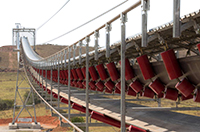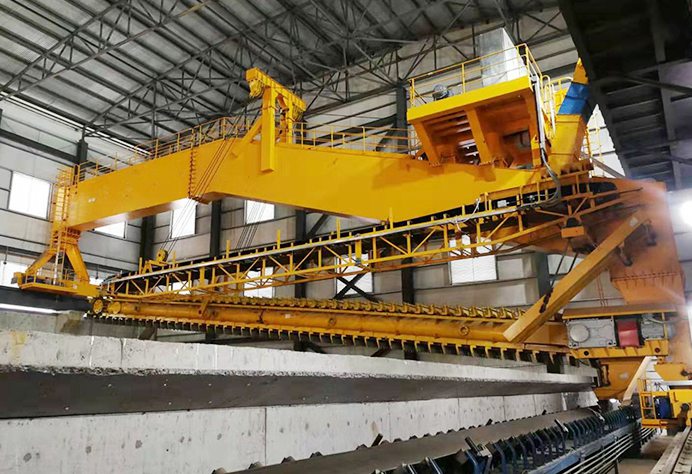The installation of the belt conveyor can be roughly divided into the following steps. belt conveyor for bulk materials
1. Preparation before installation
First, be familiar with the drawings. By looking at the drawings, understand important information such as the structure of the equipment, the installation form, the composition and quantity of parts, and performance parameters. Then familiarize yourself with important installation dimensions and technical requirements on the drawings. If there are no special installation requirements, the general technical requirements for belt conveyors are:
(1) The centerline of the frame and the longitudinal centerline of the conveyor should coincide with the deviation not greater than 2mm.
(2) The straightness deviation of the frame centerline should not be greater than 5mm within any 25m length.
(3) The vertical deviation of the frame legs to the ground should not be greater than 2/1000.
(4) The allowable deviation of the intermediate frame spacing is plus or minus 1.5mm, and the height difference should not be greater than 2/1000 of the spacing.
(5) The horizontal centerline of the roller and the longitudinal centerline of the conveyor should coincide with the deviation not greater than 2mm.
(6) The vertical deviation between the roller axis and the longitudinal centerline of the conveyor should not be greater than 2/1000, and the horizontal deviation should not be greater than 1/1000.
Equipment backlog work
During the construction period, a large number of purchased equipment cannot be placed on the construction site. This requires the equipment to be installed to be picked out and marked for hoisting. Before re-shipping, try to find out all the equipment to be installed and used, and re-ship them in place at one time, which not only saves the cost of car shifts, but also improves work efficiency. After the equipment is transported and hoisted in place, the installation site must be surveyed to eliminate the unfavorable factors affecting the equipment installation.
2. Installation of equipment
Whether a belt conveyor can meet the design and installation requirements and run normally and smoothly depends on the installation accuracy of the drive device, drum and tail wheel. Whether the center of the belt conveyor bracket coincides with the center line of the drive device and tail wheel, so the installation Pay-off is particularly important.
(1) Pay off
We can use theodolite to mark between the nose (drive device) and the tail (tail wheel), and then use the ink fountain to bounce the line point by point, so that the center line between the nose and the tail is connected into a straight line. The wire can guarantee higher installation accuracy.
(2) Installation of drive device
The driving device is mainly composed of a motor, a reducer, a driving roller, and a bracket.
First, we assemble and place the drive roller and the bracket on the embedded plate, place a steel backing plate between the embedded plate and the bracket, and level it with a spirit level to ensure that the levelness between the four points of the bracket is less than or equal to 0.5mm.
Then, find the center dividing line of the driving drum, place the wire drop on the middle dividing line, and adjust the longitudinal and horizontal middle dividing lines of the driving drum to coincide with the base center line.
When adjusting the elevation of the driving drum, a certain margin should be reserved for the adjustment of the elevation of the motor and reducer. Since the connection between the motor and the reducer has been adjusted on the bracket during the equipment manufacturing, our task is to align and level, and to ensure the coaxiality between the reducer and the drive drum.
When adjusting, take the drive roller as the reference. Since the connection between the reducer and the drive roller is a nylon rod elastic connection, the accuracy of the coaxiality can be appropriately relaxed and adjusted to be less than or equal to 0.2mm in the radial direction and no more than 2/1000 in the end surface.
(3) Installation of tail wheel
The tail wheel is composed of a bracket and a roller, and the adjustment steps are the same as those of the driving roller.
(4) Installation of outriggers, intermediate frame, roller support, and roller
Most of the belt conveyor legs are H-shaped, and their length and width vary according to the belt length and width, belt transportation volume, etc.
Below, we take a leg with a width of 1500mm as an example, the specific operation method is as follows:
â‘ Measure the center line in the width direction first and make a mark.
② Put the outriggers on the pre-embedded board on the foundation and drop the vertical line with a line to make the centerline of the outrigger width coincide with the centerline of the foundation.
③ Make a mark at any point on the center line of the foundation (generally within 1000mm is appropriate), use this mark as the base point, and measure the distance from this point to the two legs with a box ruler. According to the principle of isosceles triangle, it can be known that when two When the dimensions are equal, the outriggers are aligned.
â‘Ł The middle frame can be installed by welding the legs firmly. It is made of No. 10 or 12 channel steel. Holes with a diameter of 12 or 16mm are drilled in the width direction of the channel steel to connect the roller bracket. The connection form between the middle frame and the outrigger is welding, and the level gauge is used for measurement during installation to ensure the levelness and parallelism of the middle frame. For the two channels in the direction of parallelism, the upper row of holes should be symmetrical by diagonal measurement The degree of alignment is to ensure the smooth installation of the roller bracket and the upper centering bracket.
⑤ Install the supporting roller bracket on the middle frame, connect it with bolts, and install the supporting roller on the supporting roller bracket. It should be noted that the rollers below the blanking opening are four sets of rubber rollers, which play a buffer and shock absorption role.
â‘Ą Install the lower parallel idler and lower centering idler.
3. Installation of accessories and safety devices
The installation of accessories can only be carried out after putting a belt on the bracket. Accessories include guide chute, empty section cleaner, head cleaner, anti-deflection switch, chute, belt tensioner, etc.
(1) Chute and guide trough
The chute is installed on the blanking opening, the lower part is connected with the material guide groove, and the material guide groove is installed on the top of the tail belt. The mineral material enters the chute from the discharge port, and then enters the guide trough from the chute. The guide trough evenly distributes the mineral material in the center of the belt to prevent the mineral material from splashing.
(2) Cleaner
The empty section cleaner is installed on the lower belt of the machine tail to clean the mineral material of the lower belt.
The head cleaner is installed at the lower part of the head drum to clean the upper belt mineral material.
(3) Tensioning device
The tension device is divided into spiral tension, vertical tension, horizontal car type tension and so on. The screw tensioner is integrated with the tail bracket, composed of a nut and a screw, and is generally used for short belts. Vertical tensioning and cart-style tensioning are used for longer belts.
(4) Install the device
Safety devices include head guards, tail guards, rope switches, etc. The safety device is installed on the rotating part of the belt conveyor to protect it.
After the above methods and steps of operation, and to ensure a certain accuracy range, through the no-load and load test, and adjust the belt deviation, you can run smoothly and safely.








